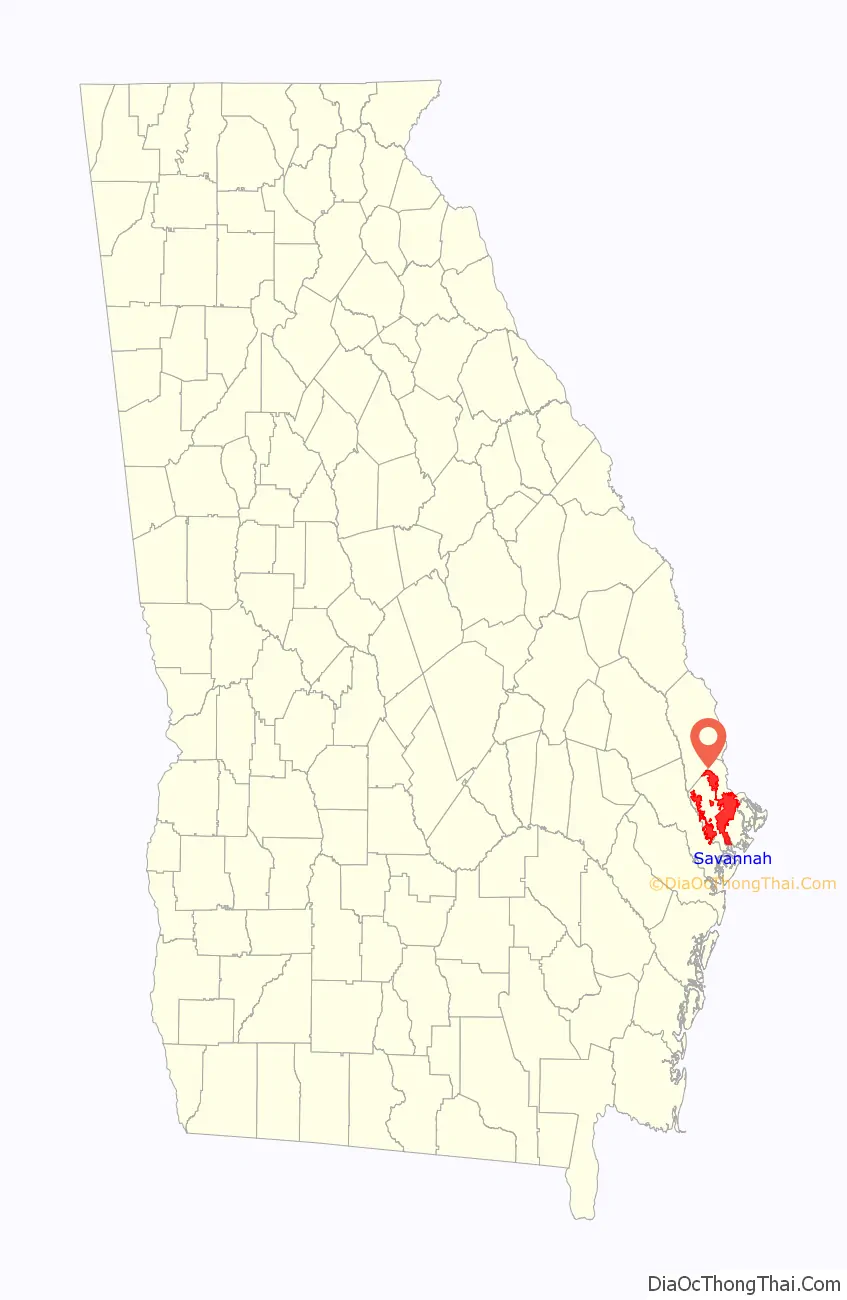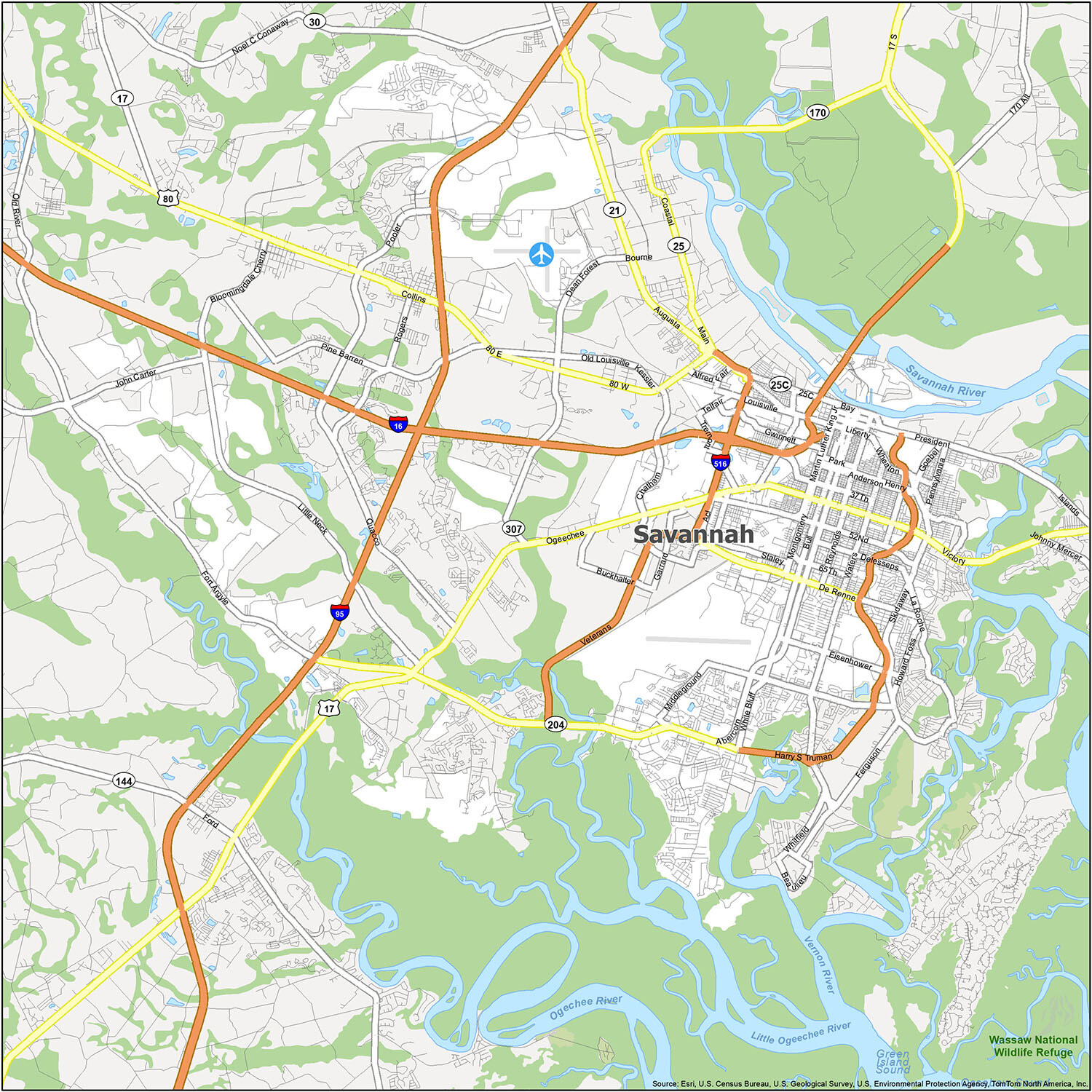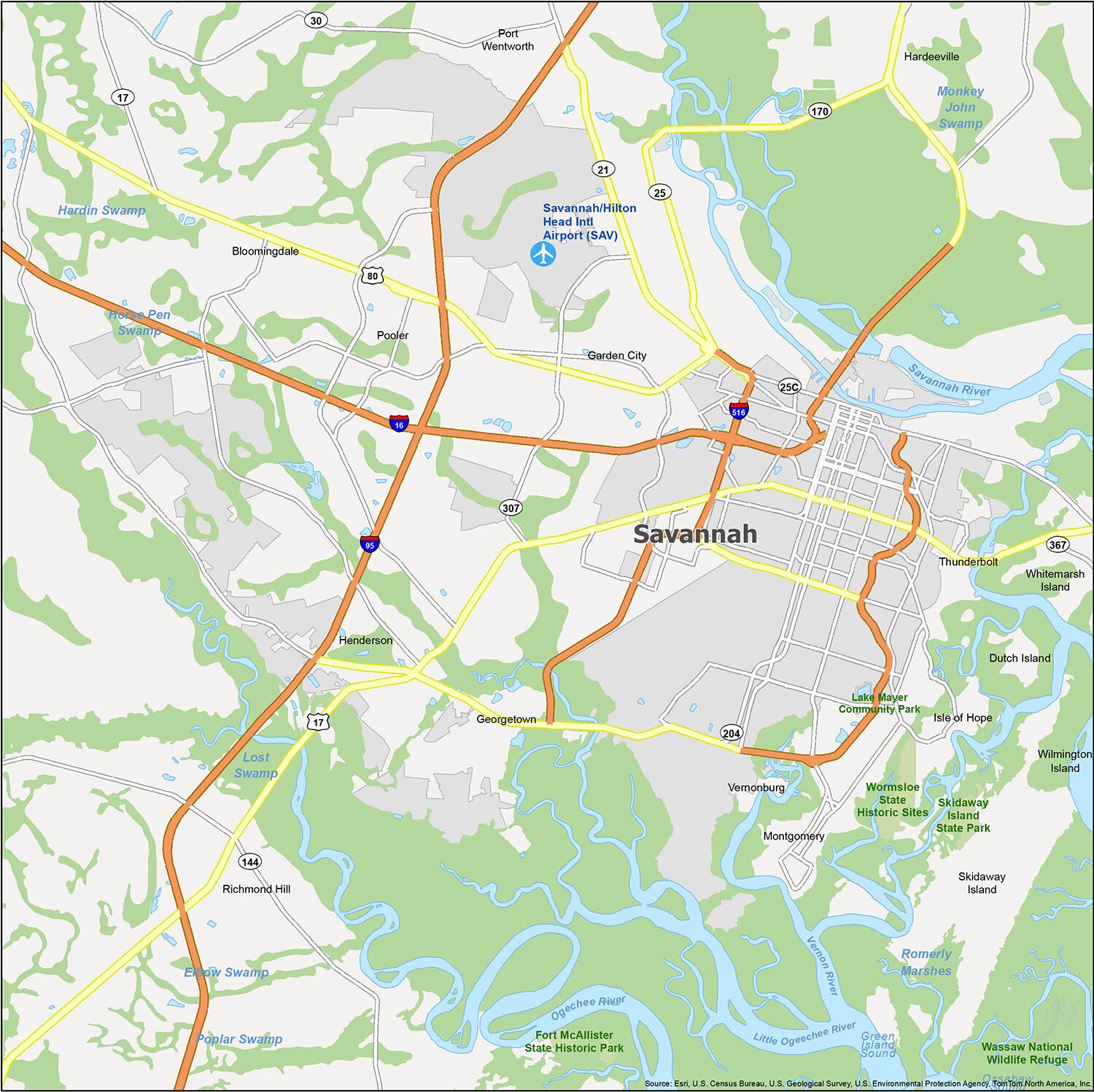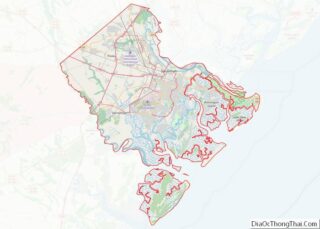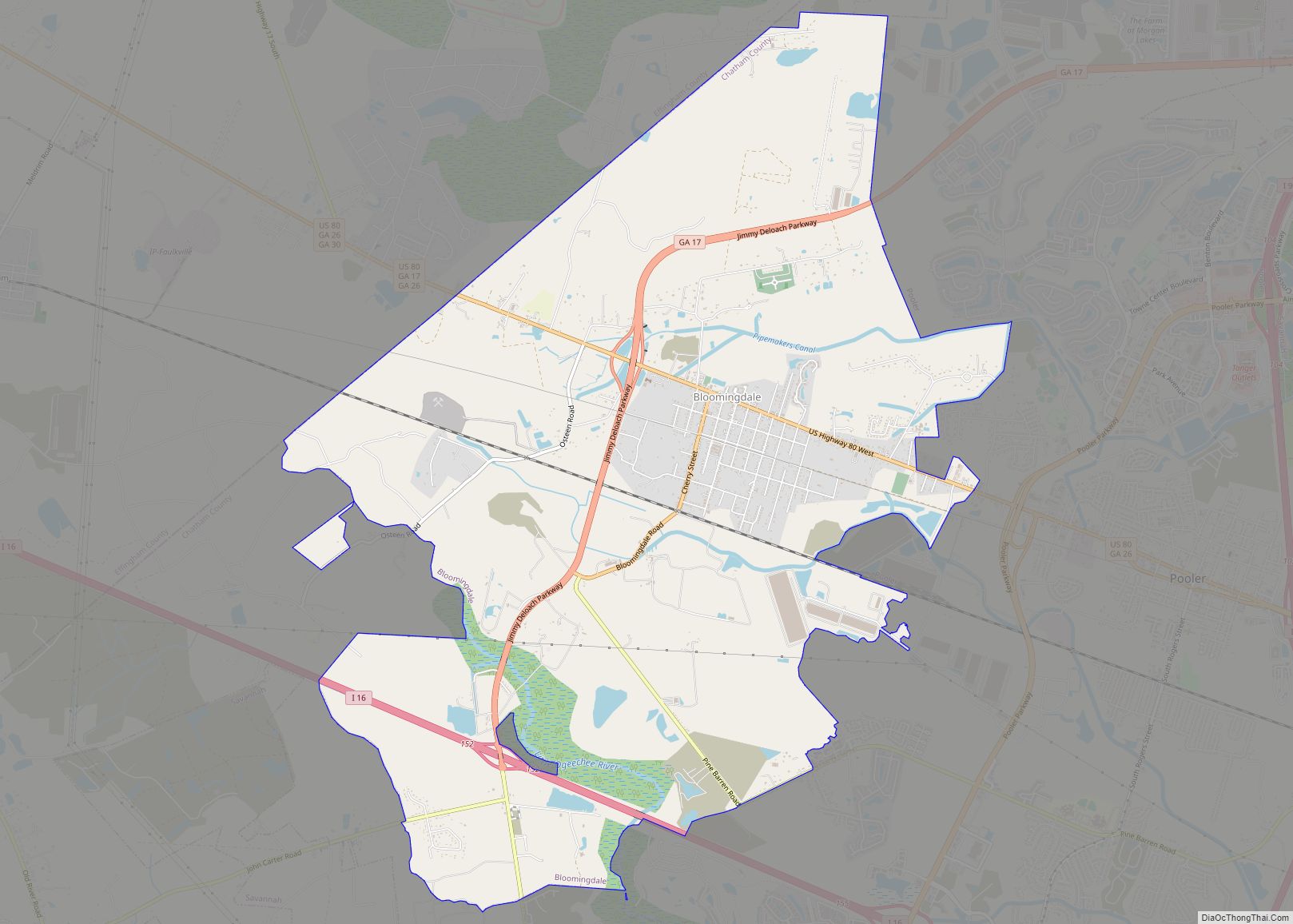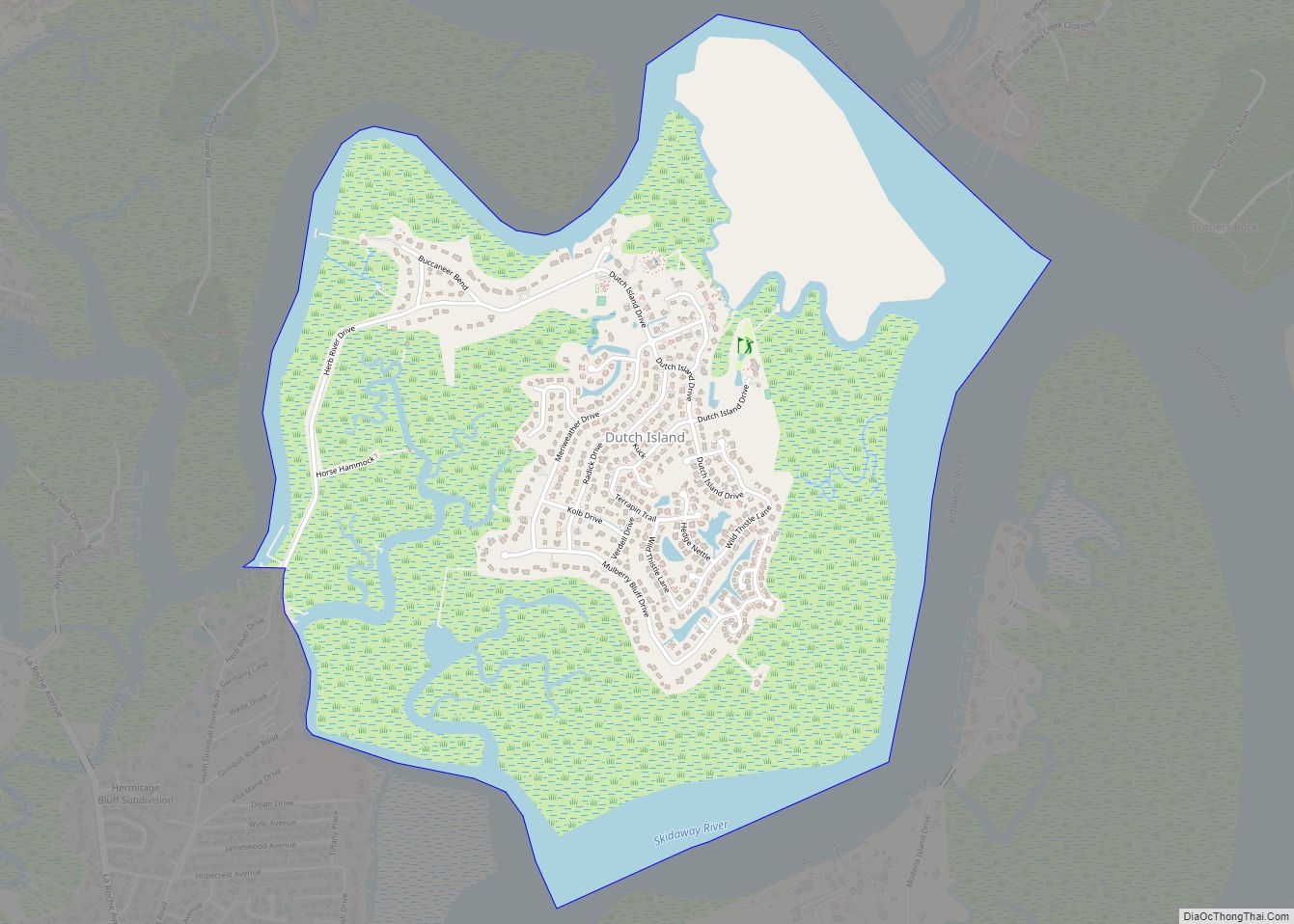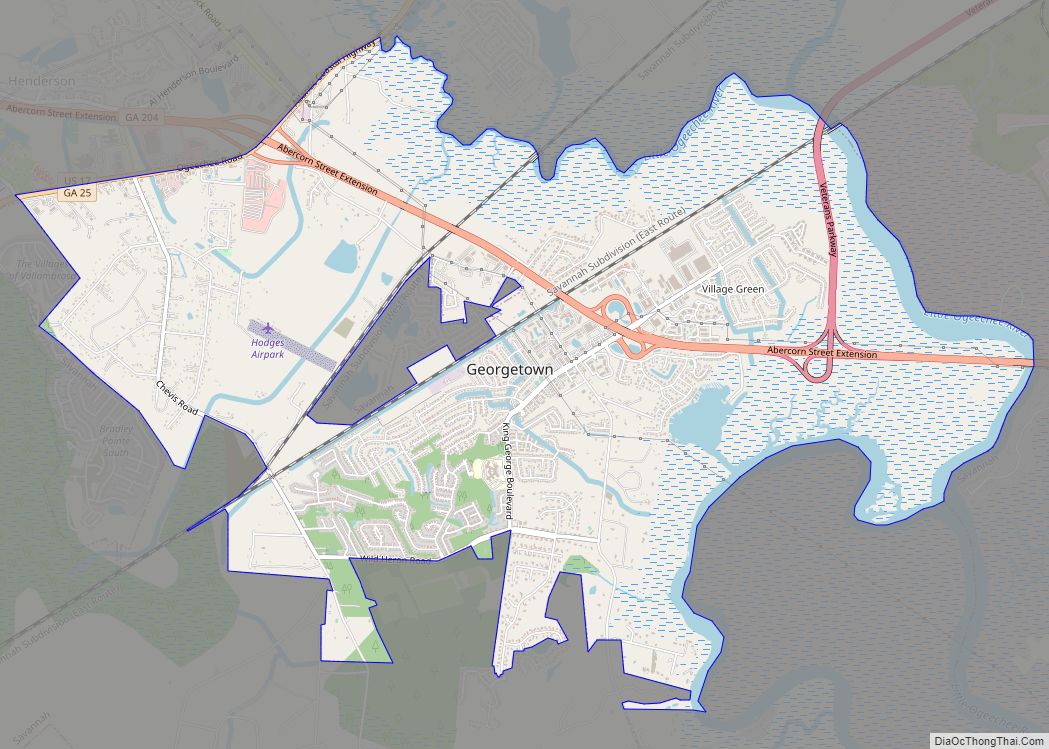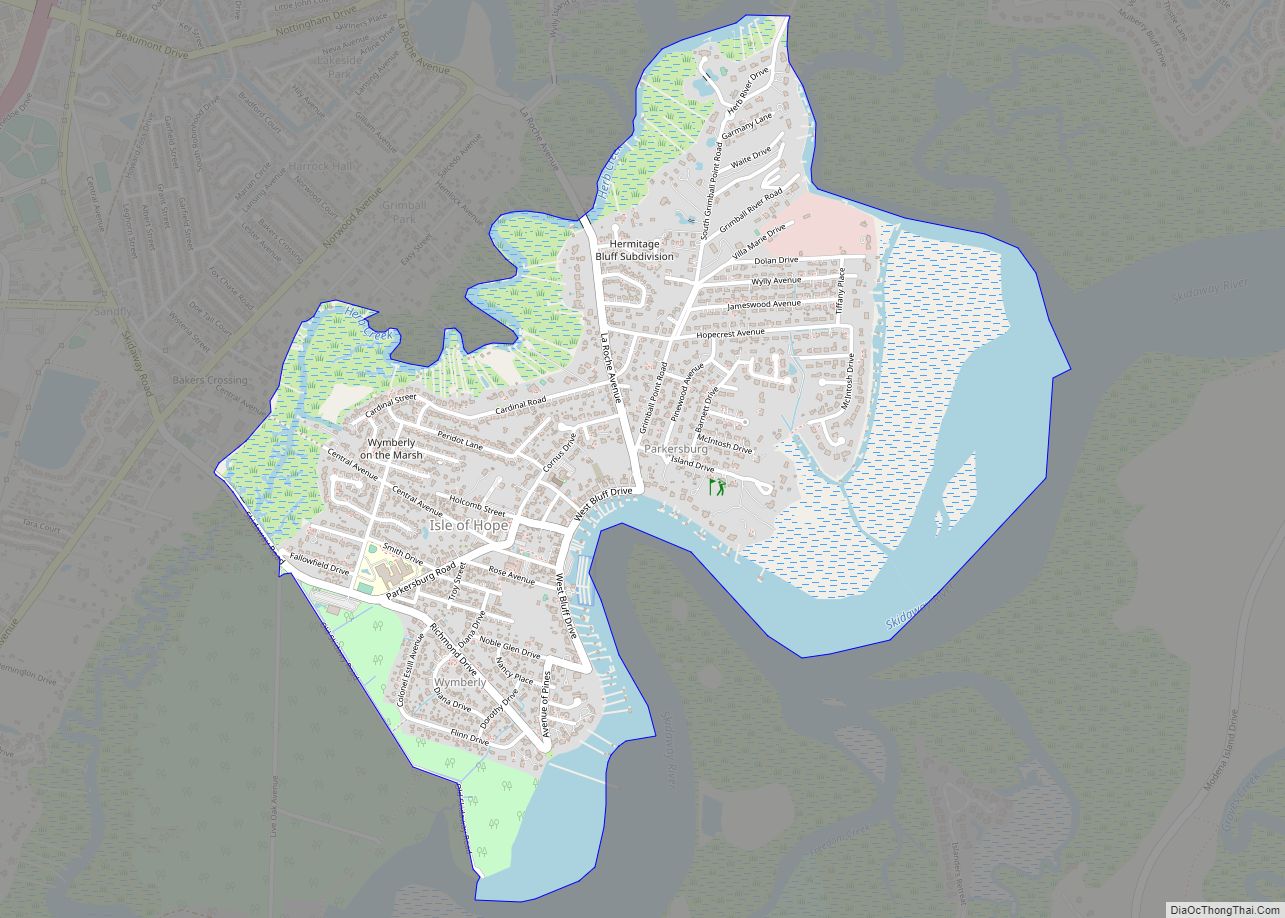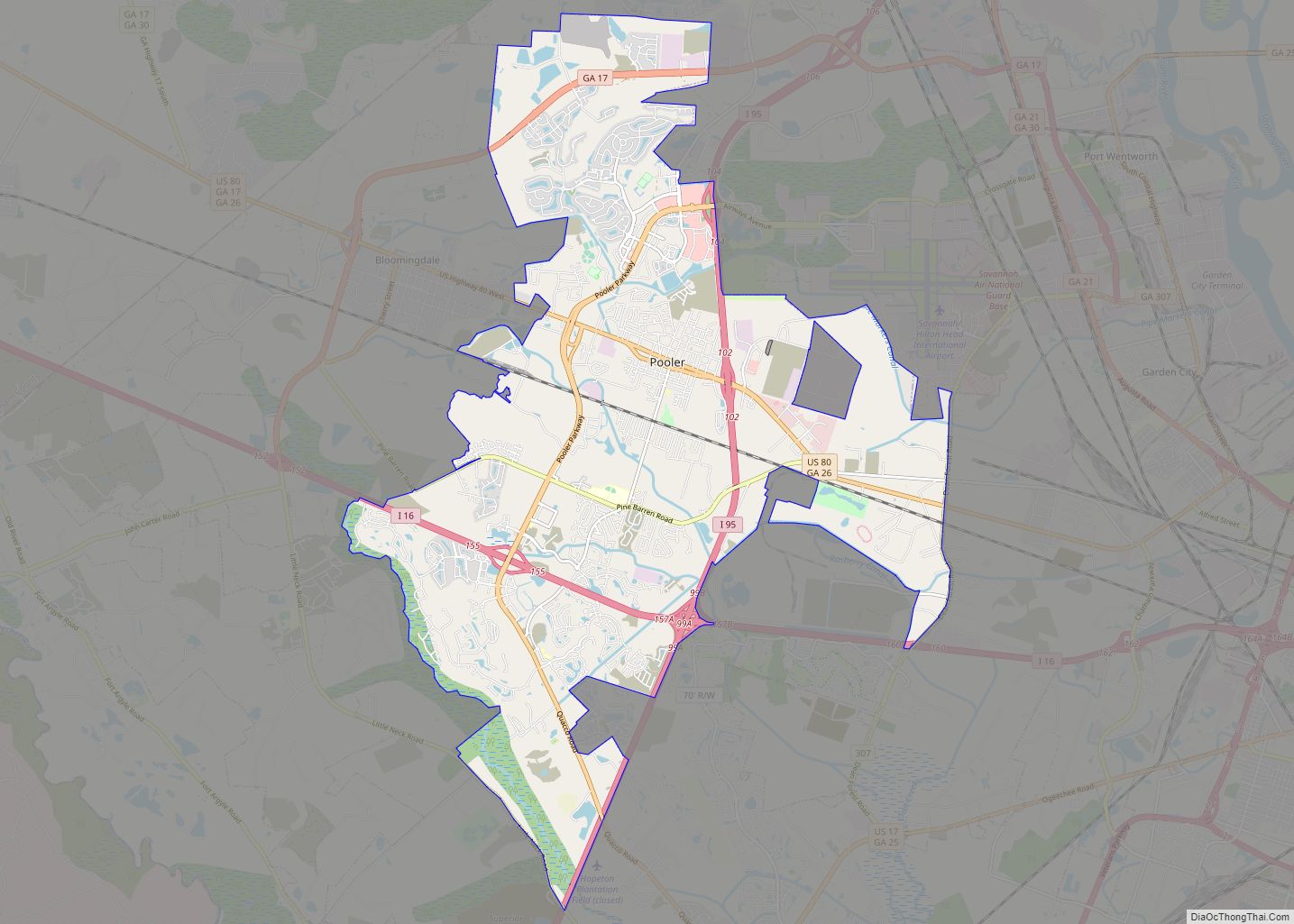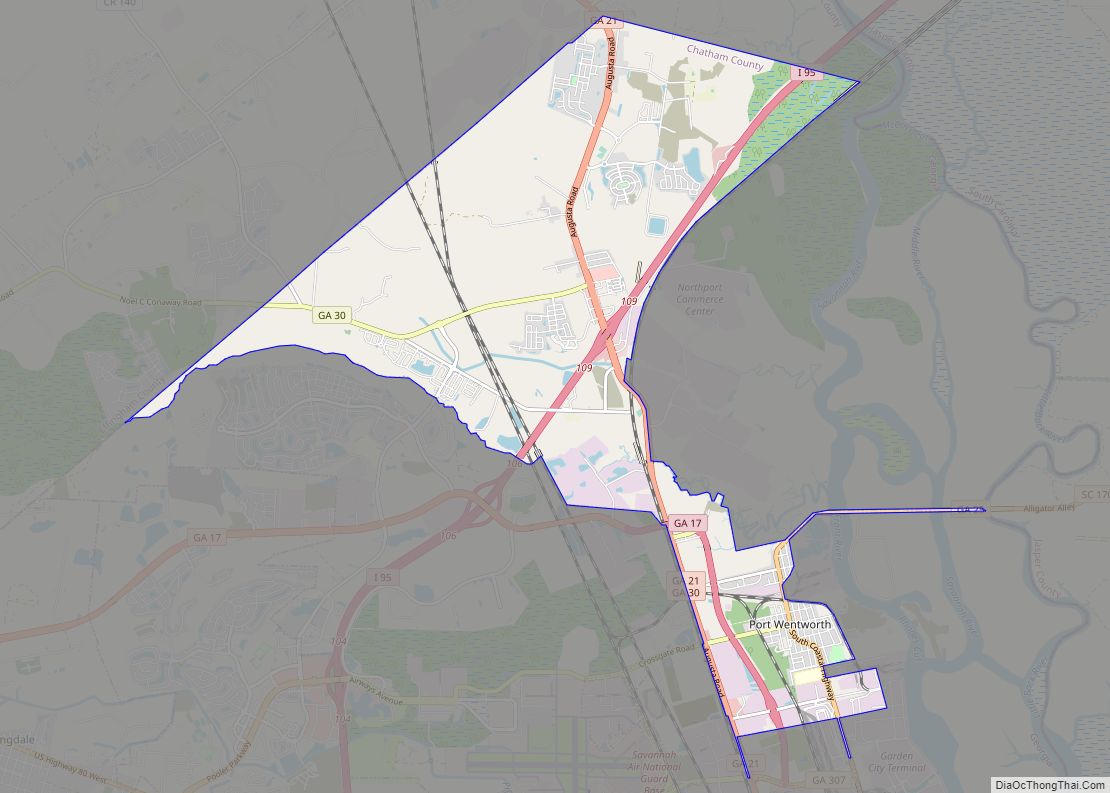Savannah (/səˈvænə/ sə-VAN-ə) is the oldest city in the U.S. state of Georgia and is the county seat of Chatham County. Established in 1733 on the Savannah River, the city of Savannah became the British colonial capital of the Province of Georgia and later the first state capital of Georgia. A strategic port city in the American Revolution and during the American Civil War, Savannah is today an industrial center and an important Atlantic seaport. It is Georgia’s fifth-largest city, with a 2020 U.S. Census population of 147,780. The Savannah metropolitan area, Georgia’s third-largest, had a 2020 population of 404,798.
Each year, Savannah attracts millions of visitors to its cobblestone streets, parks, and notable historic buildings. These buildings include the birthplace of Juliette Gordon Low (founder of the Girl Scouts of the USA), the Georgia Historical Society (the oldest continually operating historical society in the South), the Telfair Academy of Arts and Sciences (one of the South’s first public museums), the First African Baptist Church (one of the oldest African-American Baptist congregations in the United States), Temple Mickve Israel (the third-oldest synagogue in the U.S.), and the Central of Georgia Railway roundhouse complex (the oldest standing antebellum rail facility in the U.S. and now a museum and visitor center).
Savannah’s downtown area, which includes the Savannah Historic District, its 22 parklike squares, and the Savannah Victorian Historic District, is one of the largest National Historic Landmark Districts in the United States (designated by the federal government in 1966). Downtown Savannah largely retains the founder James Oglethorpe’s original town plan, a design now known as the Oglethorpe Plan. During the 1996 Summer Olympics hosted by Atlanta, Savannah held sailing competitions in the nearby Wassaw Sound.
| Name: | Savannah city |
|---|---|
| LSAD Code: | 25 |
| LSAD Description: | city (suffix) |
| State: | Georgia |
| County: | Chatham County |
| Elevation: | 20 ft (6 m) |
| Land Area: | 108.50 sq mi (281.01 km²) |
| Water Area: | 4.77 sq mi (12.35 km²) |
| Population Density: | 1,300/sq mi (500/km²) |
| Area code: | 912 |
| FIPS code: | 1369000 |
| GNISfeature ID: | 0322590 |
| Website: | www.savannahga.gov |
This Savannah Georgia map displays roads, highways, and things to do. If you want to explore the city in more detail, our interactive map provided by Google Maps is the perfect tool. Savannah is located in east Georgia along the Atlantic Ocean and borders the state of South Carolina in the north. The Little Ogeechee River outlines its southern border, while the Savannah River delineates its northern border.
Are you ready to explore Savannah? Our Savannah map collection is the perfect guide for your next trip. From the city’s historic districts to its bustling nightlife, there’s something for everyone in Savannah. Start planning your trip today and explore the city with our interactive map.
Online Interactive Map
Click on ![]() to view map in "full screen" mode.
to view map in "full screen" mode.
Get a detailed, up-to-date map of the Savannah area. With this interactive map, you will be able to get a better understanding of the city and its attractions. It’s easy to use and allows you to zoom in and out so you can get a better view of the entire city. This will also help you plan your trip and make the most out of your time in Savannah.
Savannah location map. Where is Savannah city?
History
On February 12, 1733, General James Oglethorpe and settlers from the ship Anne landed at Yamacraw Bluff and were greeted by Tomochichi, the Yamacraws, and Indian traders John and Mary Musgrove. Mary Musgrove often served as an interpreter. The city of Savannah was founded on that date, along with the colony of Georgia. In 1751, Savannah and the rest of Georgia became a Royal Colony and Savannah was made the colonial capital of Georgia.
By the outbreak of the American Revolutionary War, Savannah had become the southernmost commercial port in the Thirteen Colonies. British troops took the city in 1778, and the following year a combined force of American and French soldiers, including Haitians, failed to rout the British at the Siege of Savannah. The British did not leave the city until July 1782. In December 1804 the state legislature declared Milledgeville the new capital of Georgia.
Savannah, a prosperous seaport throughout the nineteenth century, was the Confederacy’s sixth most populous city and the prime objective of General William T. Sherman’s March to the Sea. Early on December 21, 1864, local authorities negotiated a peaceful surrender to save Savannah from destruction, and Union troops marched into the city at dawn.
Savannah was named for the Savannah River, which probably derives from variant names for the Shawnee, a Native American people who migrated to the river in the 1680s. The Shawnee destroyed another Native people, the Westo, and occupied their lands at the head of the Savannah River’s navigation on the fall line, near present-day Augusta. These Shawnee, whose Native name was Ša·wano·ki (literally, “southerners”), were known by several local variants, including Shawano, Savano, Savana and Savannah. Another theory is that the name Savannah refers to the extensive marshlands surrounding the river for miles inland, and is derived from the English term “savanna,” a kind of tropical grassland, which was borrowed by the English from Spanish sabana and used in the Southern Colonies. (The Spanish word comes from the Taino word zabana.) Still other theories suggest that the name Savannah originates from Algonquian terms meaning not only “southerners” but perhaps “salt.”
Savannah Road Map
Explore the city of Savannah with this road map. It features all the major interstates, highways, and roads in and around the city. Download and print the map to plan your route and get the most out of your trip. But if you plan on leaving the city, take a look at our Georgia road map with statewide highway information.
Take a look at this Savannah Georgia reference map and get a sneak peek of the parks, forests, and populated areas available in the area. Whether you’re looking for an amazing view, history, or culture, this map can help you plan the perfect stay. Explore the airports, cities, census-designated places, towns, and parks/forests that make up the area. From Savannah/Hilton Head International Airport (SAV) to Ft. McAllister State Historic Park to Lake Mayer Community Park, you’ll be sure to find something to make your trip memorable!
10 things to do in Savannah city
When you plan your stay in Savannah, you’ll be able to explore the city and enjoy all it has to offer. With this map, you’ll be able to make the most of your trip and see all the city has to offer.
Explore the city of Savannah and its rich history with this map designed to help you plan your stay in Savannah. From historical sites, museums, and parks, this map will give you the information you need to make the most of your trip. We highly recommend these 10 things to do while you’re in Savannah:
- Forsyth Park
- Savannah Historic District
- Owens-Thomas House & Slave Quarters
- Wormsloe Historic Site
- The Cathedral of St. John the Baptist
- Bonaventure Cemetery
- Sorrel Weed House
- Wormsloe Historic Site
- American Prohibition Museum
- Temple Mickve Israel Archives
Whether you’re looking to explore the city, its culture, and its history, this map will be your guide. With this map, you’ll be able to make the most of your stay in Savannah and see all the city has to offer.
Savannah city Satellite Map
Geography
Savannah lies on the Savannah River, approximately 20 mi (32 km) upriver from the Atlantic Ocean. According to the United States Census Bureau (2011), the city has a total area of 108.7 square miles (281.5 km), of which 103.1 square miles (267.0 km) is land and 5.6 square miles (15 km) is water (5.15%). Savannah is the primary port on the Savannah River and the largest port in the state of Georgia. It is also located near the U.S. Intracoastal Waterway. Georgia’s Ogeechee River flows toward the Atlantic Ocean some 16 miles (26 km) south of downtown Savannah, and forms the southern city limit.
Savannah is prone to flooding, due to abundant rainfall, an elevation at just above sea level, and the shape of the coastline, which poses a greater surge risk during hurricanes. The city currently uses five canals. In addition, several pumping stations have been built to help reduce the effects of flash flooding.
Climate
Savannah’s climate is classified as humid subtropical (Köppen Cfa). In the Deep South, this is characterized by long and almost tropical summers and short, mild winters. Savannah records few days of freezing temperatures each year (and has rare snowfall). Due to its proximity to the Atlantic coast, Savannah rarely experiences temperatures as extreme as those in Georgia’s interior. Nevertheless, the extreme temperatures have officially ranged from 105 °F (41 °C), on July 20, 1986 and July 12, 1879, down to 3 °F (−16 °C) during the January 1985 Arctic outbreak.
Seasonally, Savannah tends to have hot and humid summers with frequent (but brief) thunderstorms that develop in the warm and tropical air masses, which are common. Although summers in Savannah are frequently sunny, half of Savannah’s annual precipitation falls during the months of June through September. Average dewpoints in summer range from 67.8 to 71.6 °F (20 to 22 °C). Winters in Savannah are mild and sunny with average daily high temperatures of 61.4 °F (16 °C) in January. November and December are the driest months recorded at Savannah–Hilton Head International Airport. Each year Savannah reports 21 days on average with low temperatures below freezing, though in some years fewer than 10 nights will fall below freezing, and the city has even gone an entire winter season (that of 1879-80) without recording a freeze. Although decades might pass between snowfall events, Savannah has experienced snow on rare occasions, most notably in December 1989, when up to 3.9 inches (9.9 cm) was recorded in one day in parts of the city.
Savannah is at risk for hurricanes, particularly of the Cape Verde type of storms that take place during the peak of the season. Because of its location in the Georgia Bight (the arc of the Atlantic coastline in Georgia and northern Florida) as well as the tendency for hurricanes to re-curve up the coast, Savannah has a lower risk of hurricanes than some other coastal cities such as Charleston, South Carolina. Savannah was seldom affected by hurricanes during the 20th century, with one exception of being hit by Hurricane David in 1979. However, the historical record shows that the city was frequently affected during the second half of the 19th century. The most prominent of these storms was the 1893 Sea Islands hurricane, which killed at least 2,000 people. (This estimate may be low, as deaths among the many impoverished rural African Americans living on Georgia’s barrier islands may not have been reported.)
Savannah was most recently affected by an active 2016 hurricane season, including Hurricane Matthew (which made a partial eyewall landfall), and was brushed by Hurricane Irma in 2017.
The first meteorological observations in Savannah probably occurred at Oglethorpe Barracks circa 1827, continuing intermittently until 1850 and resuming in 1866. The Signal Service began observations in 1874, and the National Weather Service has kept records of most data continually since then; since 1948, Savannah-Hilton Head International Airport has served as Savannah’s official meteorological station. Annual records (dating back to 1950) from the airport’s weather station are available on the web.
Urban
Savannah is a city of diverse neighborhoods. More than 100 distinct neighborhoods can be identified in six principal areas of the city: Downtown (Landmark Historic District and Victorian District), Midtown, Southside, Eastside, Westside, and Southwest/West Chatham (recently annexed suburban neighborhoods).
Besides the Savannah Historic District, one of the nation’s largest, five other historic districts have been formally demarcated:
- Savannah Victorian Historic District
- Cuyler–Brownsville District
- Thomas Square Historic District
- Pin Point Historic District
- Ardsley Park–Chatham Crescent Historic District
See also
Map of Georgia State and its subdivision:- Appling
- Atkinson
- Bacon
- Baker
- Baldwin
- Banks
- Barrow
- Bartow
- Ben Hill
- Berrien
- Bibb
- Bleckley
- Brantley
- Brooks
- Bryan
- Bulloch
- Burke
- Butts
- Calhoun
- Camden
- Candler
- Carroll
- Catoosa
- Charlton
- Chatham
- Chattahoochee
- Chattooga
- Cherokee
- Clarke
- Clay
- Clayton
- Clinch
- Cobb
- Coffee
- Colquitt
- Columbia
- Cook
- Coweta
- Crawford
- Crisp
- Dade
- Dawson
- Decatur
- DeKalb
- Dodge
- Dooly
- Dougherty
- Douglas
- Early
- Echols
- Effingham
- Elbert
- Emanuel
- Evans
- Fannin
- Fayette
- Floyd
- Forsyth
- Franklin
- Fulton
- Gilmer
- Glascock
- Glynn
- Gordon
- Grady
- Greene
- Gwinnett
- Habersham
- Hall
- Hancock
- Haralson
- Harris
- Hart
- Heard
- Henry
- Houston
- Irwin
- Jackson
- Jasper
- Jeff Davis
- Jefferson
- Jenkins
- Johnson
- Jones
- Lamar
- Lanier
- Laurens
- Lee
- Liberty
- Lincoln
- Long
- Lowndes
- Lumpkin
- Macon
- Madison
- Marion
- McDuffie
- McIntosh
- Meriwether
- Miller
- Mitchell
- Monroe
- Montgomery
- Morgan
- Murray
- Muscogee
- Newton
- Oconee
- Oglethorpe
- Paulding
- Peach
- Pickens
- Pierce
- Pike
- Polk
- Pulaski
- Putnam
- Quitman
- Rabun
- Randolph
- Richmond
- Rockdale
- Schley
- Screven
- Seminole
- Spalding
- Stephens
- Stewart
- Sumter
- Talbot
- Taliaferro
- Tattnall
- Taylor
- Telfair
- Terrell
- Thomas
- Tift
- Toombs
- Towns
- Treutlen
- Troup
- Turner
- Twiggs
- Union
- Upson
- Walker
- Walton
- Ware
- Warren
- Washington
- Wayne
- Webster
- Wheeler
- White
- Whitfield
- Wilcox
- Wilkes
- Wilkinson
- Worth
- Alabama
- Alaska
- Arizona
- Arkansas
- California
- Colorado
- Connecticut
- Delaware
- District of Columbia
- Florida
- Georgia
- Hawaii
- Idaho
- Illinois
- Indiana
- Iowa
- Kansas
- Kentucky
- Louisiana
- Maine
- Maryland
- Massachusetts
- Michigan
- Minnesota
- Mississippi
- Missouri
- Montana
- Nebraska
- Nevada
- New Hampshire
- New Jersey
- New Mexico
- New York
- North Carolina
- North Dakota
- Ohio
- Oklahoma
- Oregon
- Pennsylvania
- Rhode Island
- South Carolina
- South Dakota
- Tennessee
- Texas
- Utah
- Vermont
- Virginia
- Washington
- West Virginia
- Wisconsin
- Wyoming

